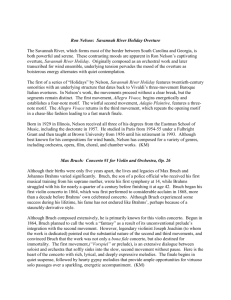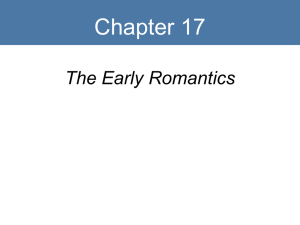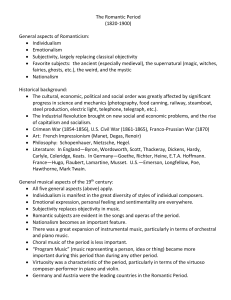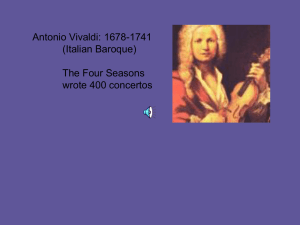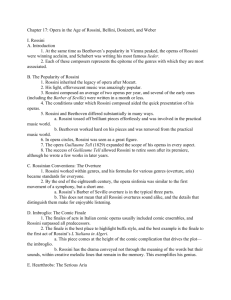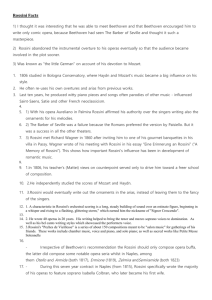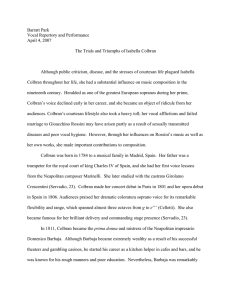November 2014
advertisement
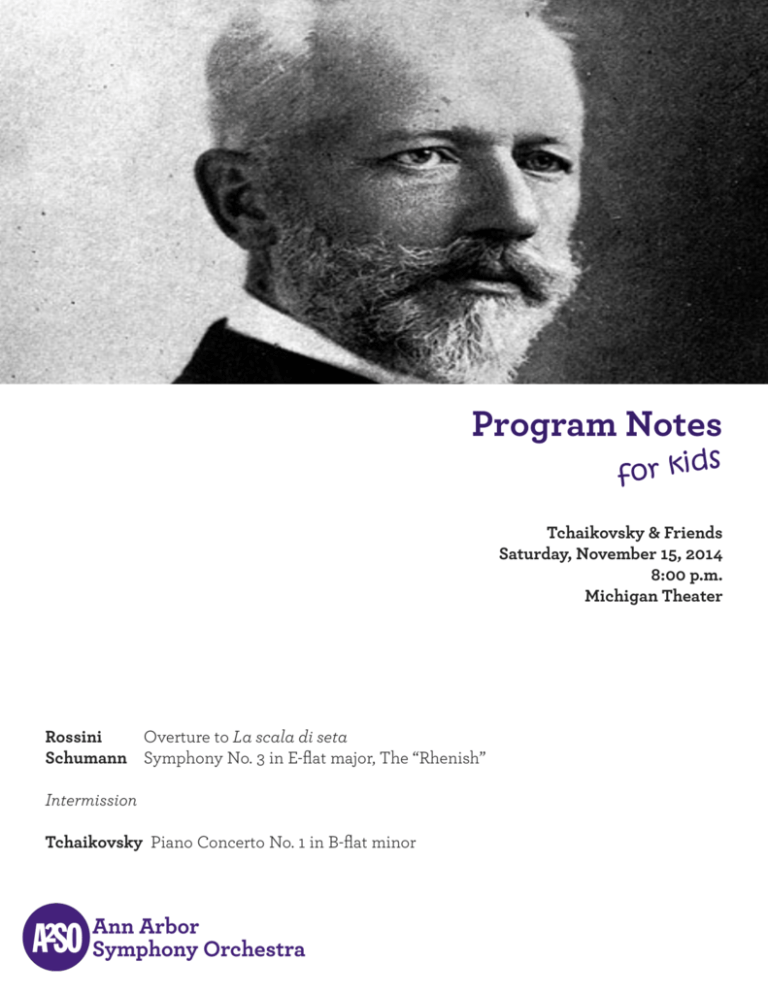
Program Notes s for kid Tchaikovsky & Friends Saturday, November 15, 2014 8:00 p.m. Michigan Theater Rossini Overture to La scala di seta Schumann Symphony No. 3 in E-flat major, The “Rhenish” Intermission Tchaikovsky Piano Concerto No. 1 in B-flat minor The Teatro Rossini in Rossini’s hometown, Pesaro, Italy (photo courtesy of Lorenzo Gaudenzi.) Overture to La scala di seta by Giaochino Rossini Listen for... Rossini loved writing crescendos: gradual increases in the volume of the music. Listen for the orchestra to play repetitive patterns that get louder and louder. About the Music What kind of piece is this? This piece was written to be the Overture – or the opening instrumental movement – of an opera. The start of an overture would signal to the audience that it was time to quiet down and find their seats as the performance was about to begin. It would preview some of the important musical themes that would be sung later in the opera. When was it written? The opera was first performed in Venice in 1812 when Rossini was only 20 years old. He wrote five operas that year. What is it about? La scala di seta (The Silken Ladder) is a comic opera. It is the story of four people seeking love and being matchmakers. And two of them are already secretly married! One of the female characters has constructed a silk ladder to allow her secret husband to climb up into her bedroom. Fun facts Rossini was an excellent chef, and when he retired he devoted himself to cooking. Many French dishes are named after him (“alla Rossini”). If you’re ever in France look for Tournedos Rossini on restaurant menus. It is a steak, fried in butter, served on top of a crouton, topped with foie gras, garnished with slices of black truffle, and finished with a Madeira demi-glace sauce. About the Composer Giaochino Rossini | Born February 29, 1792 in Pesaro, Italy | Died November 13, 1868 in Paris, France Family & Career Rossini was born to a musical family: his father was a horn player and his mother was a singer. By the age of 6, Rossini was playing triangle in his father’s musical group. He began to study cello when he was 14 and had his first opera performed when he was only 18. When he was 30 years old, Rossini met Beethoven. The old, deaf composer told him to never write anything but comic opera because he was so good at it. Music Rossini is best known for his operas The Barber of Seville and William Tell (and its famous overture). Symphony No. 3 in E-flat major, The “Rhenish” by Robert Schumann About the Music What kind of piece is this? A Symphony is a long piece of music that usually contains four movements. These movements, or sections, each have their own characteristics. Some movements may be upbeat and lively, while others may be slower and more lyrical. This symphony has five movements and is about a half-hour long. Listen for... Can you hear flowing notes that are meant to sound like the waves of the Rhine River in the second movement? The trombones don’t play until the fourth movement. But when they do it is a grand, solemn fanfare. When was it written? Schumann wrote this piece in 1850 after a trip with his wife Clara to the Rhineland, an area of Western Germany. What is it about? Schumann was very careful not to give his music descriptive titles. He didn’t want to tell people what to hear, but preferred that they form their own ideas. Nevertheless, we know some of Schumann’s inspiration for his 3rd symphony. Schumann originally wrote “Morning on the Rhine” above the second movement. In this movement, he uses a German folk dance to depict the calm, flowing Rhine River. And, the fourth movement was inspired by a visit to the Cologne Cathedral, which was recently finished after 600 years of construction. Schumann originally wrote that this movement should be “in the character of an accompaniment to a solemn ceremony,” but then he changed that to simply say “Solemn.” About the Composer Robert Schumann | Born June 18, 1810 in Zwickau, Germany | Died July 29, 1856 in Endenich, Germany Family & Career Schumann studied to be a lawyer, but then left that profession to pursue his dream of becoming a pianist. After injuring his hand, he devoted himself to composition. Schumann married Clara Wieck, a pianist and composer and the daughter of his piano teacher. They had eight children. The Rhine river in Amsterdam (photo courtesy of Joan Nova.) Fun facts Clara was much more famous than Robert in their lifetime. When Robert traveled with her on her concert tours, people often asked if he was a musician, too. Schumann was also a music critic. He invented two fictional characters who argued about modern music: Florestan, who was very passionate and fiery, and Eusebius, who was more calm and thoughtful. Music Schumann wrote a lot of music including piano music, songs for voice and piano, four symphonies, and one opera. Two of his most famous works are his Scenes from Childhood (13 piano pieces in which he reminisces about his childhood) and Album for the Young (a collection of 43 short piano pieces that he wrote for his daughters). Piano Concerto No. 1 in B-flat minor by Pyotr Ilyich Tchaikovsky Listen for... The pianist plays a cadenza near the end of the first movement. This is a section where the soloist plays by himself and is allowed to improvise, or make up music on the spot. This is a chance for the pianist to show off his technical skills and his musical imagination. You’ll notice that the other musicians will put their instruments down and the conductor will stop conducting to listen. About the Music What kind of piece is this? A Concerto is a piece of music written for a solo instrument with an orchestra. In this case, the piano player is the soloist, so he sits at the front of the stage and plays the most important part. Concertos usually have three movements. When was it written? Tchaikovsky wrote this concerto in 1874 and 1875, but then continued to revise it for thirteen years. What is it about? You can tell from the title, “Piano Concerto No. 1,” that this work isn’t really about anything. But people have speculated that it is about a French singer named Désirée Artôt, whom Tchaikovsky had a relationship with. He used the melody of one of her favorite songs, “Il faut s’amuser, danser et rire” (“One must amuse oneself, dancing and singing”), in the second movement. And the German names for the musical notes spell out a part of her name in the sweet melody of the first movement. We’ll never know if this was his intention or just an accident, but there is clearly something romantic about the music. The melody at the beginning of the work became a popular song in the 1940s called “Tonight we love.” About the Composer Tchaikovsky may have been thinking of this woman, the singer Désirée Artôt., when he wrote his Piano Concerto. Fun facts The music from Tchaikovsky’s ballet Sleeping Beauty was used in the Disney movie of the same name. During the 2014 Winter Olympics in Sochi, Russia, Tchaikovsky’s music featured prominently in the opening and closing ceremonies. Pyotr IlyichTchaikovsky | Born May 7, 1840 in Votkinsk, Russia | Died November 6, 1893 in St. Petersburg, Russia Family & Career Tchaikovsky grew up with four brothers, two sisters, and a French nanny. When he was 10, he was sent to a boarding school 800 miles away from his family. While there, he entertained himself by going to the opera with his friends and by improvising music on the piano. When a School of Music opened in St. Petersburg in 1862, Tchaikovsky became one of its first students. Tchaikovsky later became Russia’s first full-time professional musician. Music Tchaikovsky is best known for his three ballets (Nutcracker, Swan Lake, and Sleeping Beauty), six symphonies, and the 1812 Overture.

